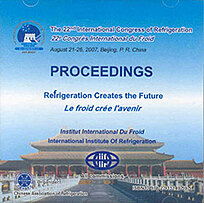
Résumé
The old aim of governments was to supply their country with sufficient low-cost energy to keep the economy growing. Nowadays, the climate change requires a reduction of the energy use, mainly the use of fossil fuels, which are the main producers of CO2 emissions. Heat pumps offer the possibility of reducing energy consumption and CO2 emissions significantly, mainly in the building sector, but also in industry. The second law of thermodynamics shows the advantages: While a condensing gas-fired boiler can reach a primary energy ratio of at best 105% (based on the lower calorific value), heat pumps achieve 200 to 400%, depending on the operating conditions. The potential for reducing CO2 emissions assuming a 30% share of heat pumps in the building sector using technology presently available is about 6% of the total world-wide CO2 emissions. With advanced future technologies in power generation, in improved heat pumps used in integrated systems and in advanced control strategies 16% seem to be possible. Therefore, heat pumps are one of the key technologies for energy conservation, for reducing CO2 emissions and for reducing the effects of the climate change.
Documents disponibles
Format PDF
Pages : ICR07-E2-834
Disponible
Prix public
20 €
Prix membre*
Gratuit
* meilleur tarif applicable selon le type d'adhésion (voir le détail des avantages des adhésions individuelles et collectives)
Détails
- Titre original : Heat pumps.
- Identifiant de la fiche : 2007-2285
- Langues : Anglais
- Sujet : Technologie, Environnement, Généralités
- Source : ICR 2007. Refrigeration Creates the Future. Proceedings of the 22nd IIR International Congress of Refrigeration.
- Date d'édition : 21/08/2007
Liens
Voir d'autres communications du même compte rendu (839)
Voir le compte rendu de la conférence
Indexation
- Thèmes : Pompes à chaleur, récupération d'énergie : généralités
- Mots-clés : Technologie; Sol-eau; Généralité; Pompe à chaleur; Environnement; Frigorigène
-
Ground-coupled heat pumps or heating-only and h...
- Auteurs : HALOZAN H., RIEBERER R.
- Date : 22/04/2003
- Langues : Anglais
- Source : Cryogenics and refrigeration. Proceedings of ICCR 2003.
Voir la fiche
-
Techno-economic analysis on ground-source and a...
- Auteurs : LI Y. C., CHAN G. M., HUANG Y. Y., et al.
- Date : 22/04/2003
- Langues : Anglais
- Source : Cryogenics and refrigeration. Proceedings of ICCR 2003.
Voir la fiche
-
Energy and exergy analysis of direct expansion ...
- Auteurs : WANG X., MA C., ZHENG P.
- Date : 21/08/2007
- Langues : Anglais
- Source : ICR 2007. Refrigeration Creates the Future. Proceedings of the 22nd IIR International Congress of Refrigeration.
- Formats : PDF
Voir la fiche
-
Development of a design and performance predict...
- Auteurs : NAGANO K., KATSURA T., NOGAWA T., et al.
- Date : 02/05/2005
- Langues : Anglais
- Source : 8th IEA Heat Pump Conference 2005: global advances in heat pump technology, applications, and markets. Conference proceedings [CD-ROM].
Voir la fiche
-
Heat transfer characteristics of a multiple bor...
- Auteurs : ZHANG Q., MURPHY W. E.
- Date : 17/08/2003
- Langues : Anglais
- Source : 21st IIR International Congress of Refrigeration: Serving the Needs of Mankind.
- Formats : PDF
Voir la fiche
